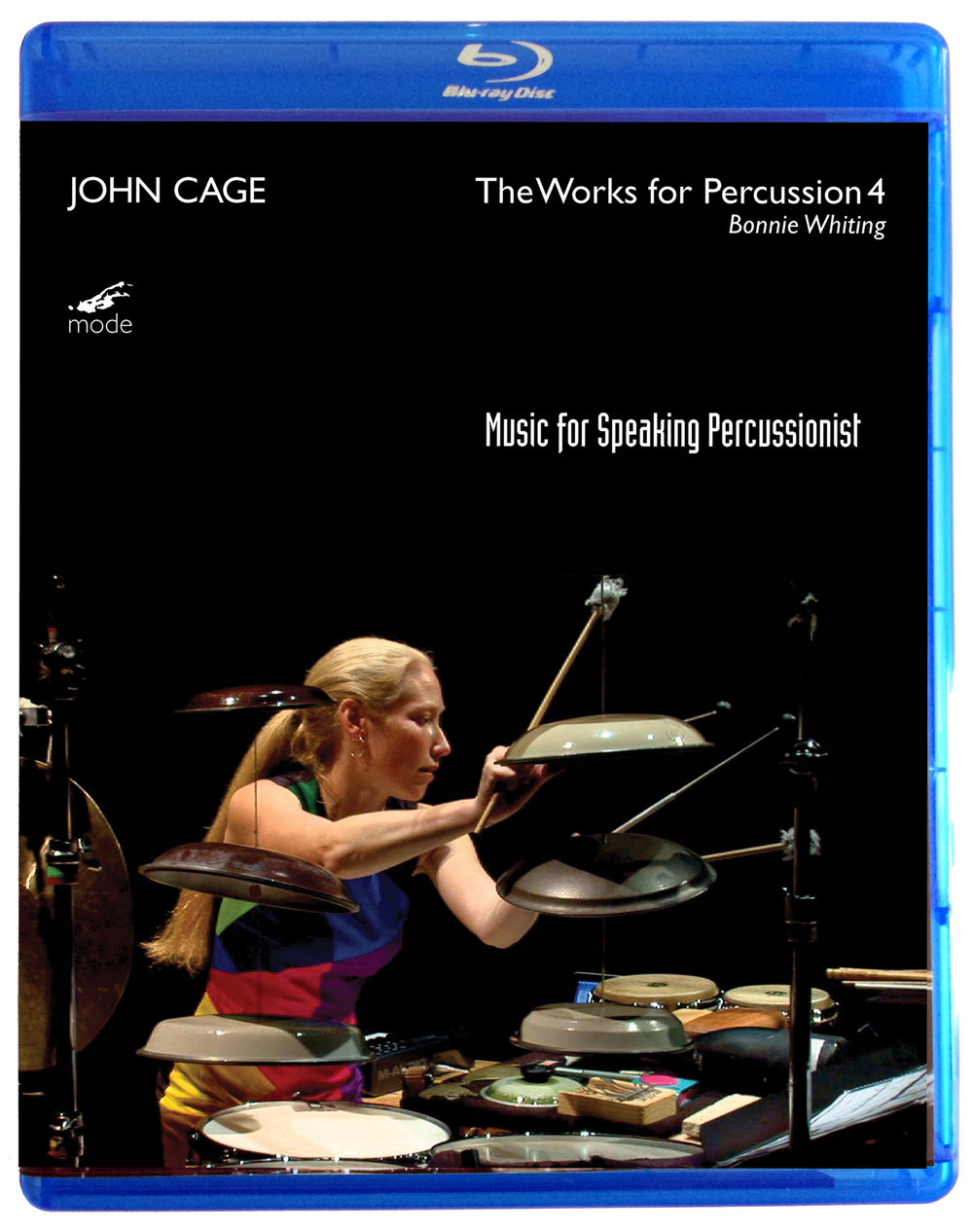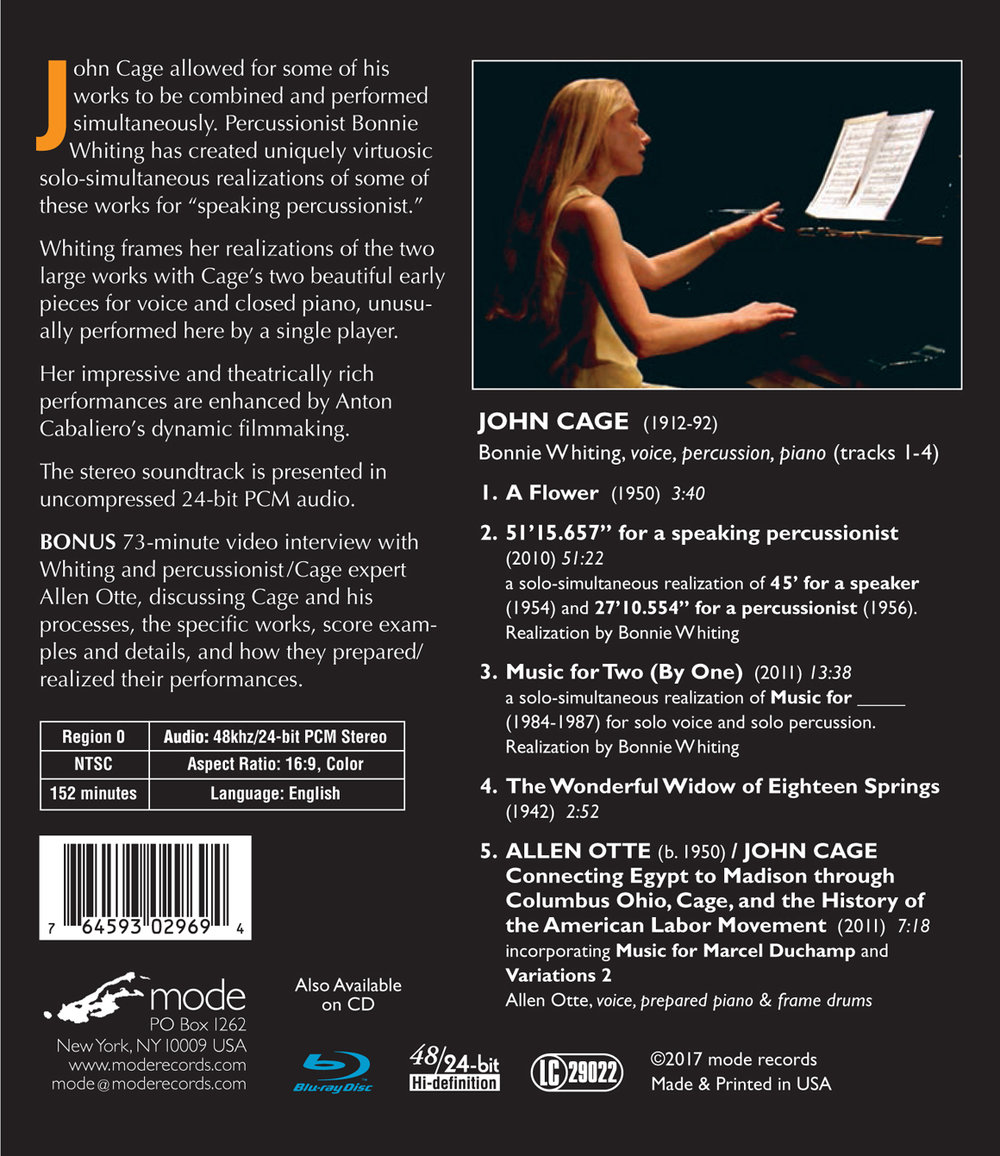John Cage Music for Speaking Percussionist compilation (also called The Works for Percussion 4 by Mode Records). Performed 2010-2011 at the University of California, San Diego. Features percussionists Bonnie Whiting and Allen Otte. Directed, filmed, and edited for TV by Anton Cabaleiro; music recorded and edited by Josef Kucera; produced by Allen Otte and Brian Brandt. Released 2017, disc has uncompressed 48kHz/24-bit PCM stereo sound. We usually exclude Blu-ray titles with only stereo sound. But we do make exceptions for classical music soloists when the recording otherwise has some special merit. Here we have a famous (among lovers of contemporary music anyway) percussionists performing rarely (or never-before) recorded works with instruments that would probably not benefit much or at all from surround sound. Grade: A-
This is our first title from Mode Records, which is the brainchild of Brian Brandt. Brandt is himself interviewed in another Blu-ray on our Alphalist, the John Cage - Journeys in Sound from Accentus Recordings.
There are five pieces of music on this disc:
A Flower. (1950) A short "traditional piece" composed by Cage played by singing while tapping on the closed keyboard lid of a piano.
The Wonderful Widow of Eighteen Springs. (1942) Another short Cage piece for singer and closed-keyboard-lid.
51'15.657'' for a speaking percussionist by Bonnie Whiting. (2010) Note that 51'15.657'' refers to the length of the piece—51 minutes and 15.657 seconds.
Music for Two (By One) by Bonnie Whiting. (2011) The two Whiting works are "mashups" of pieces previously written by Cage. These previously-written Cage pieces were not meant to played straight through. Cage intended that future composers would take excerpts from them, combine them in different ways, and take credit for the new work.
Connecting Egypt to Madison through Columbus Ohio, Cage, and the History of the American Labor Movement by Allen Otte. (2011) This piece lasts 7'18" and incorporates Music for Marcel Duchamp and Variations 2 by Cage.
The disc also has a valuable 73-minute extra feature of a conversation between Whiting and Otte (her former professor) in which they discuss how Cage notated the works listed above and how he intended them to be used. Finally, the keepcase booklet has 10 (CD sized) pages of information in small print about Cage's composition methods and how performers today turn the scores into performances.
This title will be a special treat for fans of Cage and contemporary music. It can also serve as an excellent introduction to Cage for adventuresome viewers who have maybe heard about Cage but don't know what all the fuss is about. Or was about—Cage started inventing his music before before broadcast TV (in black and white) arrived and he died in 1992. He is now called "post-war (that's WWII) avant garde."
Time for screenshots. Below is Bonnie Whiting playing A Flower on a closed piano. This was invented for 2 performers, a singer and pianist, but Bonnie does it all. Why "invented" in the previous sentence? Schoenberg, who was for sure a composer, helped train Cage. Because Cage had little interest in harmony, Schoenberg called him an "inventor" rather than composer:
A close-up of Whiting as she sings A Flower (which is a song without words):
Below is the complete rig for 51'15.657'' for a speaking percussionist, which includes traditional instruments along with quite a few everyday household objects like pot lids. Apparently Cage did not specify what instruments the performer would use for 51'15.657'' and Music for Two (By One) except to require one or more instruments that are made of metal, wood, skin (drum), or something else. In the image below, Whiting speaks, rather dramatically, about the philosophy of music creation (we think) :
A better shot of the chandelier of what appears to be cooking containers and pot lids. Also you can see a blue and pink buzzer from the children's game Taboo:
In the next shot below you can see the written score Whiting uses calling for instrumental notes and setting out the words she recites. The score looks something like a collection of student note cards pasted in a black photograph album. It's up to Whiting to assemble these snippets of music and recitation in what ever order she wishes before the performance. This means Cage would have some idea about the structure of the piece, but no mental image of when the various structural item would be used or what a particular performance would sound like. To further complicate matters, it appears Cage would create his structural elements depending on tiny specks he could see in the paper he used! To sum all this up, Cage invented music through a process that put the design of the basic musical elements, the order of playing of the elements, and the choice of the instruments mostly outside his control. This is just one of many ideas Cage came up with as the pioneer of "indeterminacy" (or use of chance) in music.
So does this mean anything goes? Far from it. Cage gives Whiting big influence over the outcome, but he thereby imposes a moral obligation on her to do her part in exactly the manner Cage prescribes. So once she puts it all together in concept, she has to perform it correctly in real time. Cage gives Bonnie the DNA; she invokes the actual creature. You can see the strain on her face as she struggles valiantly to get it right! This was radical stuff in the 1950s and 60s when Cage was hot!
Whiting uses a different setup for Music for Two (By One), including a clay pot from her garden. This was written by Cage to be a duet. Whiting shows her chops by performing both parts simultaneously:
The final piece is performed by Allen Otte where he plays a hand drum and a weird-sounding prepared piano. This is an act of political guerrilla warfare with a spoken text that is a good bit closer to Bernie Sanders than to Donald Trump:
From the bonus interview, we see pages from several Cage scores. The typical page is a minute of time, and each set of rows is 15 seconds. The four lines are labeled M for Metal, W for Wood, S for Skin (drums), and A for Auxiliary, such as glass or stone. Each dot is a unique strike of the object, and the distance from the line indicates how strongly or softly the musician plays each item:
Below we have Bonnie Whiting's score for 51'15.657'' for a speaking percussionist. This score combines both Cage's musical notations and his text:
It appears Cage never had much commercial success with his musical surrealism. But he was a world-class networker who knew a lot people in all the arts, famous and unknown, who helped him in his wanderings over the world as teacher, inventor, and performer. He influenced many others including some we know from HDVDs such as Steve Reich and Tōru Takemitsu.
In 1969, Cage staged his HPSCHD ("Harpsichord"), a five-hour multimedia extravaganza with 7 harpsichords playing simultaneously with additional computer-generated sounds in a university music center. HPSCHD had no plot and was be visited by patrons who wandered in and out at random. This must have influenced Philip Glass, Robert Wilson, and Lucinda Childs when they later collaborated (1976) on the most famous post-war avant-garde multimedia work of all, Einstein on the Beach. Bonnie Whiting in her speaking performances on this disc sounds very like Kate Moran in her renowned performance of “I was in a prematurely air-conditioned supermarket” from Einstein on the Beach. And now you can see all of this in the comfort of you own home!
Well, if you had the passion and energy to listen to these Cage works on CDs, you would likely be thrilled to see the performance in this HDVD. I would argue that Cage benefits from video more than any other composer. But I must also point out that Cage didn't like recordings because fixing a record is inconsistent with his doctrine that the essence of modern music is derived from the introduction of chance in the performance. But now with subject title you get beautiful pictures to enjoy along with the mystifying sounds. The sound quality is very good for a stereo recording. Both Whiting and Otte speak and are recorded cleanly and clearly in English. But, of course, the text is abstruse and hard to understand.
The only quibbles I have would be in using 48/24 bit stereo sound (instead of 96/24 bit surround sound), the lack of any libretto in the booklet, and the lack of subtitles.
After debate, I decided to give this an‽ and the grade of A-. This grade is probably too high, but I don’t see any point on beating up on poor Cage and Bonnie.
Here's a clip from this production from Mode Records:
OR











